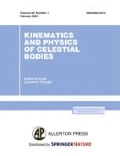Abstract
We suggest the method for determining the imaginary part n i of the complex refractive index of aerosol particles forming a cloud layer at a specified altitude in the atmosphere of a giant planet. From the data of spectral measurements of the geometric albedo of Jupiter (carried out in 1993), the value of n i was calculated for the whole atmospheric column and the pressure range of 0.52 to 0.78 bar in the cloud layer presumably composed of ammon i um hydrosulfides. The values of n i obtained for the cloud layer and the whole atmospheric column substantially differ and amount to 0.00098 and 0.00012, respectively.
Similar content being viewed by others
References
A. V. Morozhenko, “Jovian cloud stratification,” Sov. Astron. Lett. 10, 323–325 (1984).
A. V. Morozhenko, “Vertical structure of the latitude cloud bands of Jupiter,” Sol. Syst. Res. 19, 44–52 (1985).
A. V. Morozhenko, “Problems of studying the vertical structure of cloud layers in the atmospheres of giant planets,” Kinematika Fiz. Nebesnykh Tel 9, 3–26 (1993).
A. V. Morozhenko, “Difference in the vertical structure of cloud layers of giant planets,” Kinematika Fiz. Nebesnykh Tel 17, 261–278 (2001).
A. V. Morozhenko, A. S. Ovsak, A. P. Vid’machenko, V. G. Teifel, and P. G. Lysenko, “Imaginary part of the refractive index of aerosol in latitudinal belts of Jupiter’s disc,” Kinematics Phys. Celestial Bodies 32, 30–37 (2016).
A. V. Morozhenko and E. G. Yanovitskii, “Parameters of an optical model of the Jupiter atmosphere for continuous spectra in the 0.35–0.92 micron region,” Sov. Astron. Lett. 2, 20–21 (1976).
A. S. Ovsak, V. G. Teifel, and P. G. Lysenko, “Vertical structure of the volume scattering coefficient of aerosol in latitude belts of Jupiter’s disk,” Kinematics Phys. Celestial Bodies 32, 181–188 (2016).
S. K. Atreya, A. S. Wong, K. H. Baines, M. H. Wong, and T. C. Owen, “Jupiter’s ammonia clouds — localized or ubiquitous?” Planet. Space Sci. 53, 498–507 (2005).
Z. M. Dlugach and M. I. Mischenko, “The effect of aerosol shape in retrieving optical properties of cloud particles in the planetary atmospheres from the photopolarimetric data. Jupiter,” Sol. Syst. Res. 39, 102–111 (2005).
Z. M. Dlugach and M. I. Mischenko, “Photopolarimetry of planetary atmospheres: What observational data are essential for a unique retrieval of aerosol microphysics?” Mon. Not. R. Astron. Soc. 384, 64–70 (2008).
E. Karkoschka, “Spectrophotometry of the Jovian planets and Titan at 300- to 1000-nm wavelength: The methane spectrum,” Icarus 111, 174–192 (1994).
J. S. Lewis, “The clouds of Jupiter and the NH3–H2O and NH3–H2S systems,” Icarus 10, 365–378 (1969).
K. I. Matcheva, B. J. Conrath, P. J. Gierasch, and F. M. Flasar, “The cloud structure of the jovian atmosphere as seen by the Cassini/CIRS experiment,” Icarus 179, 432–448 (2005).
M. I. Mishchenko, “Physical properties of the upper tropospheric aerosols in the equatorial region of Jupiter,” Icarus 84, 296–304 (1990).
A. V. Morozhenko and A. S. Ovsak, “On the possibility of separation of aerosol and methane absorption in the long-wavelength spectral range for giant planets,” Kinematics Phys. Celestial Bodies 31, 225–231 (2015).
A. V. Morozhenko and E. G. Yanovitskii, “The optical properties of Venus and the Jovian planets I. The atmosphere of Jupiter according to polarimetric observations,” Icarus 18, 583–592 (1973).
H. B. Niemann, S. K. Atreya, G. R. Carignan, et al., “The composition of the Jovian atmosphere as determined by the Galileo probe mass spectrometer,” J. Geophys. Res.: Planets 103, 22831–22845 (1998).
A. S. Ovsak, “Upgraded technique to analyze the vertical structure of the aerosol component of the atmospheres of giant planets,” Kinematics Phys. Celestial Bodies 29, 291–300 (2013).
A. S. Ovsak, “Changes in the characteristics of the upper layers of the Jovian atmosphere from the data on the integral observations of the planetary disk,” Kinematics Phys. Celestial Bodies 31, 25–33 (2015).
A. S. Ovsak, “Variations of the volume scattering coefficient of aerosol in the Jovian atmosphere from observations of the planetary disk,” Kinematics Phys. Celestial Bodies 31, 197–204 (2015).
A. S. Ovsak, “Vertical structure of cloud layers in the atmospheres of giant planets. I. On the influence of variations of some atmospheric parameters on the vertical structure characteristics,” Solar Syst. Res. 49, 43–50 (2015).
A. S. Ovsak, V. G. Teifel, A. P. Vid’machenko, and P. G. Lysenko, “Zonal differences in the vertical structure of the cloud cover of Jupiter from the measurements of the methane absorption bands at 727 and 619 nm,” Kinematics Phys. Celestial Bodies 31, 119–130 (2015).
A. A. Simon-Miller, D. Banfield, and P. J. Gierasch, “Color and the vertical structure in Jupiter’s belts, zones, and weather systems,” Icarus 154, 459–474 (2001).
S. J. Weidenscilling and L. S. Lewis, “Atmospheric and cloud structures of the Jovian planets,” Icarus 20, 465–476 (1973).
R. A. West and M. G. Tomasko, “Spatially resolved methane band photometry of Jupiter: III. Cloud vertical structures for several axisymmetric bands and the Great Red Spot,” Icarus 41, 278–292 (1980).
Author information
Authors and Affiliations
Corresponding author
Additional information
Original Russian Text © A.V. Morozhenko, A.S. Ovsak, 2016, published in Kinematika i Fizika Nebesnykh Tel, 2016, Vol. 32, No. 6, pp. 49–55.
About this article
Cite this article
Morozhenko, A.V., Ovsak, A.S. On the possibility of determining the imaginary part of the complex refractive index of aerosol particles in an individual altitudinal cloud layer of Jupiter’s atmosphere. Kinemat. Phys. Celest. Bodies 32, 294–298 (2016). https://doi.org/10.3103/S0884591316060064
Received:
Published:
Issue Date:
DOI: https://doi.org/10.3103/S0884591316060064


